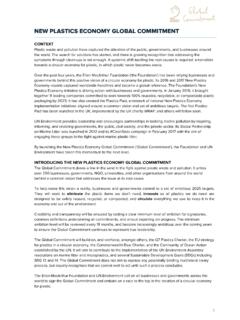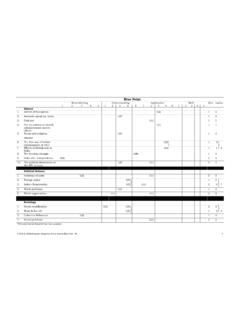Transcription of GEORGIA’S ECONOMY
1 SS8E1 The student will give examples of the kinds of goods and services produced in georgia in different historical periods. SS8E2 The student will explain the benefits of free trade. SS8E3 The student will evaluate the influence of georgia s economic growth and development. georgia S ECONOMY Special points of interest: Trade in different time periods Four transportation systems Entrepreneurs in georgia Immigrant workforce georgia s industries Inside this issue: Colonial Period and Early Statehood 2 Antebellum Period and Civil War 3 Reconstruction and Early 1900s 4 20th Century 5 The 5 Ps used to be the best way to teach our students about georgia s ECONOMY : Peaches Pecans Poultry Pine trees Peanuts Today , some of the rankings have changed and new industries have emerged.
2 In 2012, georgia produced more blueberries than peaches. Although pine trees are still abundant, georgia has not been a major naval stores producer since the 1960s. The state is a top producer of corn, tobacco and hay these days. In addition, georgia s industry is highlighted by car manufacturing, tourism, the movie industry as well as trade and service industries. Colonial Period and Early Statehood One of the reasons georgia was settled was to support the English economic policy of mercantilism. The georgia Trustees decided the new settlers would to grow grapes, indigo and mulberry trees. Grapes would be used in making wine, indigo for blue dye and the mulberry trees would host silkworms for silk production. Silk fabric was very popular and a sign of wealth during the 1700s and China was the major producer.
3 The only long term success with these early crops was with indigo. Eventually the colonists saw and heard about other crops from their South Carolina neighbors, and others, that were grown with more success than these three. In Virginia, the colonists grew tobacco. South Carolina s marshy coast was used in cultivating rice plants. The wealth that was generated by these crops tempted georgia colonists to try producing these on their own soil. In a time without machinery when colonial economies were based on agriculture, slaves were used to do most of the labor in the fields. Under the Trustees, georgia wasn t allowed to have slaves. However, seeing the success with slave labor in agriculture, georgia colonists argued to be allowed the same advantage.
4 Slaves were brought to georgia in the 1740s illegally (the Trustees still banned slavery and malcontents ignored this) . By 1751, the ban on slavery was lifted and the population and ECONOMY increased. After the American Revolution, the new cotton crop and Eli Whitney s invention of the cotton gin in 1793, further caused georgia s ECONOMY to flourish. This simple acronym helps stu-dents remember these crops: The WRIST Crops Wine Rice Indigo Silk Tobacco Antebellum Period and Civil War georgia earned her nickname The Empire State during the economic boom of the 1840s. With the introduction of Eli Whitney s cotton gin, cotton production increases 50 times. Greater amounts of cotton allow industries based on the crop to flourish. During this time, large scale gins are opened to handle the overwhelming success of cotton crops, railroads are built to distribute the cotton and mills open to kick off georgia s textile industry.
5 However, this dependence on a single crop will fail georgia in the future. Ironically, it was georgia s success that made her a target during the Civil War. Union General William T. Sherman saw the state as his main focus to be able to end the war. The burning of Atlanta and the path of destruction that went all the way to Savannah destroyed the railroads, factories, farms that supported the ECONOMY . The damage done to georgia s agricultural region and the over planting of cotton ruins the fertile soil will take decades to overcome. Reconstruction and Early 1900s Even though georgia is still reeling from the destruction of the Civil War, farmers continue to make up the largest part of the population. With the passage of the Reconstruction amendments (13th, 14th and 15th) many freed slaves continue to farm as sharecroppers and tenant farmers.
6 georgia , unsuccessfully, continues in its agrarian ECONOMY growing cotton, corn and wheat. During the New South period, the Bourbon Redeemers and Henry Grady encourage new industry and farming practices. Grady s speeches and editorials generate a level of optimism to the people of georgia . Northern investors build mills in state because of the mild climate, low taxes and cheap labor. In 1881, georgia hosts the first of three cotton exhibitions highlighting the cotton industry and economic opportunity for northern investors. A granite quarry from Elberton also displayed the first granite headstone and business generated by that showing led to the city s nickname, The Granite Capital of the World . By 1890 there were nearly 100 textile mills in operation in georgia .
7 Enough to lead to the opening of georgia Institute of Technology in 1899 to train young men in the necessary skills for running, operating and creating textile mills. In addition to the continued dependence on King Cotton , a new industry emerges the naval stores. Naval stores are products from pine trees (turpentine, rosin, lumber) that are used in the repair and maintenance of ships. Originally based in North Carolina, naval store producers came to the sparsely populated coast of georgia to make use of the pine trees. By 1890, georgia was the leading producer of naval stores. Some freed slaves left the fields for the forests to be employed by the naval store producers. In addition to agriculture and new agriculturally based industries during this time period, there were new products and companies that call georgia home.
8 Coca-Cola, invented in 1886, was an alternative to alcohol and gained popularity during the temperance movement. Atlanta Life Insurance Company was started by former slave turned entrepreneur, Alonzo Herndon, in 1905. By World War I, georgia s agriculture and industries lend support to the American soldiers. georgia was home to more training camps than any other state. Also, georgia s mills produced fabric to be used for the soldiers uniforms. The war was a boost to the state s ECONOMY . 1881 Cotton Exposition in Atlanta Alonzo Herndon Coca-Cola, 1886 20th Century In the early 1900s, georgia s ECONOMY is beginning to diversify with the continued efforts of Henry Grady and others. Factories and mills make several cotton products. Unfortunately, the boll weevil in 1915, overused soil and a severe drought in 1924 sent the state into a depression well before the rest of the nation.
9 Yet, in the face of depression, new businesses emerged in georgia . Delta Airlines begins in 1924 as a solution to the boll weevil infestation by dusting crops with insecticide in Macon. In 1927 georgia Pacific started in Augusta as a lumber mill. President Roosevelt s New Deal programs touch the state and create jobs and provide a solution to the Great Depression. As fate would have it, the United States is pulled into World War II and the united work force under the New Deal is now producing goods for the war effort. georgia again surfaces as a leader in soldier training facilities bringing young men and their families to the state. The Bell Bomber plant begins in Marietta building the B-29 bomber and employs 28,000 Georgians. Today we know this factory as Lockheed-Martin which continues to manufacture cargo and fighter planes.
10 In 1946, Truett Cathy opened the first Chic-fil-A in Hapeville. Today, it is one of the most popular restaurants in the nation. After the war, in 1955, two WWII veterans opened The Waffle House in Avondale Estates. In the 1979 the Home Depot opened two stores in Atlanta. Today, the company has stores in all 50 states and in several countries around the world. It is the 4th largest retailer in the and the 5th largest in the world! Due to the mild climate, low taxes, lack of unions and an available workforce, georgia is home to so many new industries now! Notably the movie and film industry (327 films, TV shows and commercials were made in georgia in 2011 that generated $ billion) and tourism ($21 billion generated). Today, the city of Atlanta alone ranks 4th in the number of Fortune 500 companies that are headquartered there.
















